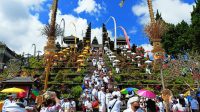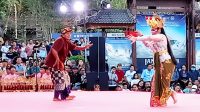BALI’S rich cultural tapestry is woven with vibrant traditional dances, many of which serve as both spiritual expressions and captivating tourist attractions. From the sacred movements of temple rituals to lively entertainment performances, Balinese dances are steeped in meaning, symbolism, and artistic tradition.
Here, we explore seven of the most beloved dances in Bali, frequently showcased to tourists, along with their deeper cultural and religious significance.
- Barong Dance: The Battle of Good and Evil
Enter a world where ancient myths come alive before your eyes. The Barong Dance is a captivating journey into Bali’s mystical folklore, where the eternal battle between good and evil unfolds in a breathtaking spectacle. Watch as Barong, the lion-like guardian spirit, clashes with the dark powers, his vibrant mask and elaborate costume weaving a story of courage, protection, and balance. Feel the pulse of Bali’s soul in every step, drumbeat, and dramatic twist — the Barong Dance is more than a performance; it’s Bali’s spirit in motion!
As representing the eternal struggle between good and evil, the Barong symbolizes positive forces and confronts Rangda, a demonic figure representing darkness.
Meaning and Significance
- The Barong embodies protective spirits, while Rangda is a manifestation of destructive chaos.
- The performance emphasizes the Balinese philosophy of Rwa Bhineda (basic dualism), the balance between opposing forces in the universe.
Tourist Appeal
- The dramatic fight between good and evil captivates tourists, making it a popular attraction in cultural centers like Ubud, Batubulan and others.
- Legong Dance: The Dance of Grace and Femininity
Grace, precision, and mystery blend in perfect harmony in the Legong Dance, Bali’s legendary ballet of elegance. With delicate hand movements, expressive eyes, and vibrant costumes, the young dancers bring to life tales of love, bravery, and myth in every precise motion. Originally, it was a court dance to entertain royalty.
Set to the hypnotic rhythm of the gamelan, this dance is a feast for the senses, drawing you into a world where tradition and beauty merge. Witness the Legong Dance and let Bali’s timeless allure captivate your heart and soul.
Meaning and Significance
- The dance reflects elegance, purity, and disciplined artistry, with stories often drawn from ancient Balinese folklore.
Tourist Appeal
- Its precise choreography and refined beauty make it a favorite among tourists seeking an authentic cultural performance.
- Kecak Dance: The Dance of a Thousand Hands
As dusk falls over Bali, the air fills with the haunting chant of “cak-cak-cak,” drawing you into the mystique of the Kecak Dance. This powerful, trance-like performance unfolds around a blazing fire, where hundreds of men, with synchronized voices and dynamic movements, recreate the epic tale of Ramayana epic, focusing on the rescue of Sita by Prince Rama and his monkey army.
With no instruments but their rhythmic chants or acapella and sheer energy, the dancers bring ancient stories to life in a way that’s raw, primal, and unforgettable. The Kecak Dance is more than a show — it’s a journey into the spirit and pulse of Bali itself.
Meaning and Significance
- The rhythmic chants symbolize the energy of the monkey army, creating an intense and hypnotic atmosphere without the need for instruments.
Tourist Appeal
- Held at sunset in locations like Uluwatu, the combination of fire, chanting, and dramatic storytelling offers an unforgettable experience for tourists.
- Pendet Dance: A Welcoming Dance
Step into the rhythm and grace of Bali with the mesmerizing ‘Pendet Dance’ — a traditional welcome dance that’s more than just art; it’s a living celebration. With each gesture, the dancers pay homage to the island’s gods and goddesses, inviting blessings and beauty. Swaying with elegance, clad in vibrant Balinese attire, their movements mirror the soul of Bali itself: warm, sacred, and eternally welcoming.
Witness the harmony of tradition and artistry in the Pendet Dance — where every graceful hand movement and expressive gaze tells a story. It’s more than a dance; it’s an invitation to feel Bali’s spirit.
Initially a temple dance, the Pendet Dance has now evolved into a welcoming dance for guests, symbolizing hospitality and devotion.
Meaning and Significance
- Pendet reflects gratitude and offerings to the gods, highlighting the island’s deep spiritual connection.
Tourist Appeal
- Often performed as a prelude to larger performances, it introduces tourists to the warmth and welcoming nature of Balinese culture.
- Sanghyang Jaran Dance: The Sacred Trance Dance
Prepare to witness the extraordinary as dusk welcomes the Sanghyang Jaran Dance, Bali’s entrancing ritual of fire and trance. Guided by ancient chants, dancers fall into a sacred state, walking barefoot over blazing embers with the spirit of the mystical ‘jaran’ (horse) guiding their every step.
This spiritual performance isn’t just a dance — it’s a powerful ceremony, a mesmerizing blend of courage and devotion where the lines between performer and spirit dissolve. When dancers enter a trance, they are believed to be possessed by spirits, to protect the community during times of crisis.
So, experience the Sanghyang Jaran and feel the intensity of Bali’s spiritual heartbeat!
Meaning and Significance
- Performed during ceremonies to purify and drive away evil, it reflects the Balinese belief in spiritual balance and protection.
Tourist Appeal
- Tourists are fascinated by the trance-like state of the dancers and the ritualistic fire-walking, providing a rare glimpse into Balinese spirituality.
- Ramayana Ballet: An Epic Tale of Love and Heroism
Step into a timeless epic brought to life under the Balinese night sky with the Ramayana Ballet. This enchanting performance fuses intricate dance, vibrant costumes, and mesmerizing gamelan music to tell the ancient love story of Rama and Sita, a tale of devotion, heroism, and triumph over darkness.
With every graceful gesture and expressive gaze, the dancers invite you into a world where gods, kings, and mythical creatures collide. The Ramayana Ballet is more than a performance; it’s an unforgettable journey into the heart of Bali’s rich cultural legacy.
Meaning and Significance
- The ballet is a powerful representation of dharma (righteousness), devotion, and the victory of good over evil.
- It holds a deep spiritual significance in both Hindu and Balinese culture, teaching the importance of morality and righteousness in life.
Tourist Appeal
- The grand, theatrical performance is a spectacle for tourists, often set against the backdrop of Bali’s stunning temples or cultural centers.
- Tourists enjoy the intricate costumes, complex choreography, and the epic storyline, which is a cornerstone of Hindu mythology.
- Joged Bumbung: The Flirtatious Dance
Get ready for a dance like no other with ‘Joged Bumbung,’ Bali’s lively, flirtatious, and joy-filled performance! Accompanied by the rhythmic beats of bamboo instruments, this social dance invites spectators to join in the fun, blending improvisation with playful interaction.
Dancers move with elegance and humor, charming the crowd with every spin and gesture. Joged Bumbung isn’t just a dance; it’s a lively celebration of connection, laughter, and the warmth of Balinese culture. Embrace the beat, and let yourself be drawn into the joy of Bali’s most spirited dance!
Meaning and Significance
- Unlike sacred dances, Joged Bumbung is purely for entertainment and often involves spontaneous interactions with male audience members, who are invited to dance with the performers.
- The dance represents social joy and light-heartedness, reflecting the festive side of Balinese culture.
Tourist Appeal
- Tourists are often invited to join the dance, making it an interactive experience.
- The upbeat music played on bamboo instruments (bumbung) and the cheerful, playful nature of the dance make it an exciting, engaging performance that appeals to visitors looking for cultural entertainment.
Conclusion
These eight Balinese dances offer a wide spectrum of cultural experiences, from the deeply spiritual Sanghyang Jaran and Barong to the lively and interactive Joged Bumbung. Each dance provides tourists with a unique window into Balinese life, blending art, spirituality, and storytelling. Whether watching the hypnotic movements of the Kecak or participating in the joyous Joged Bumbung, visitors to Bali are sure to be captivated by the island’s dynamic and vibrant dance traditions. Through these performances, Bali not only preserves its cultural heritage but also shares its soul with the world.










